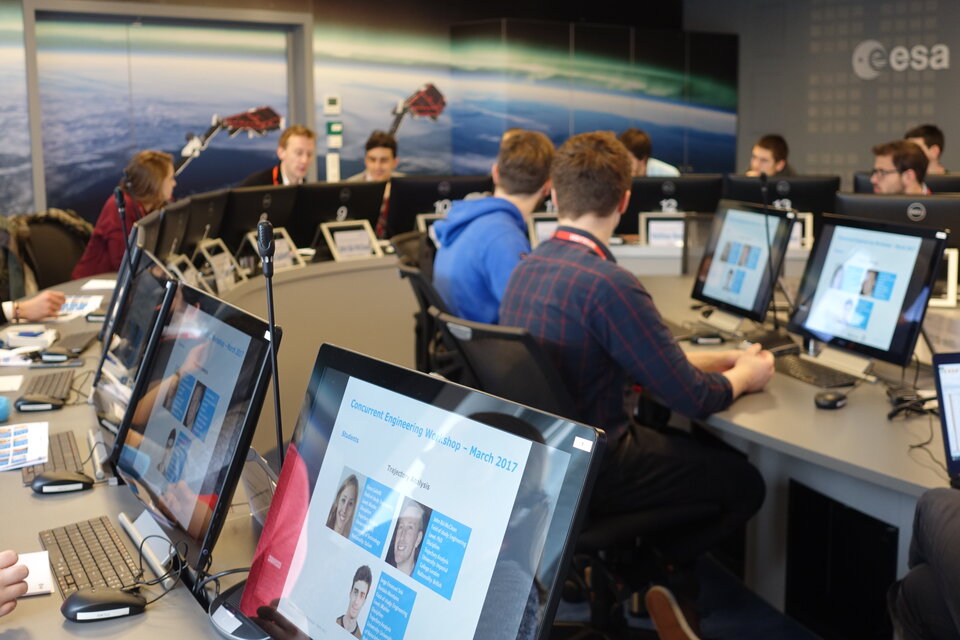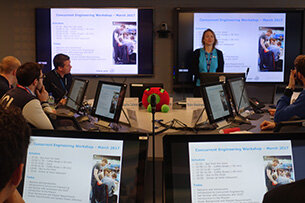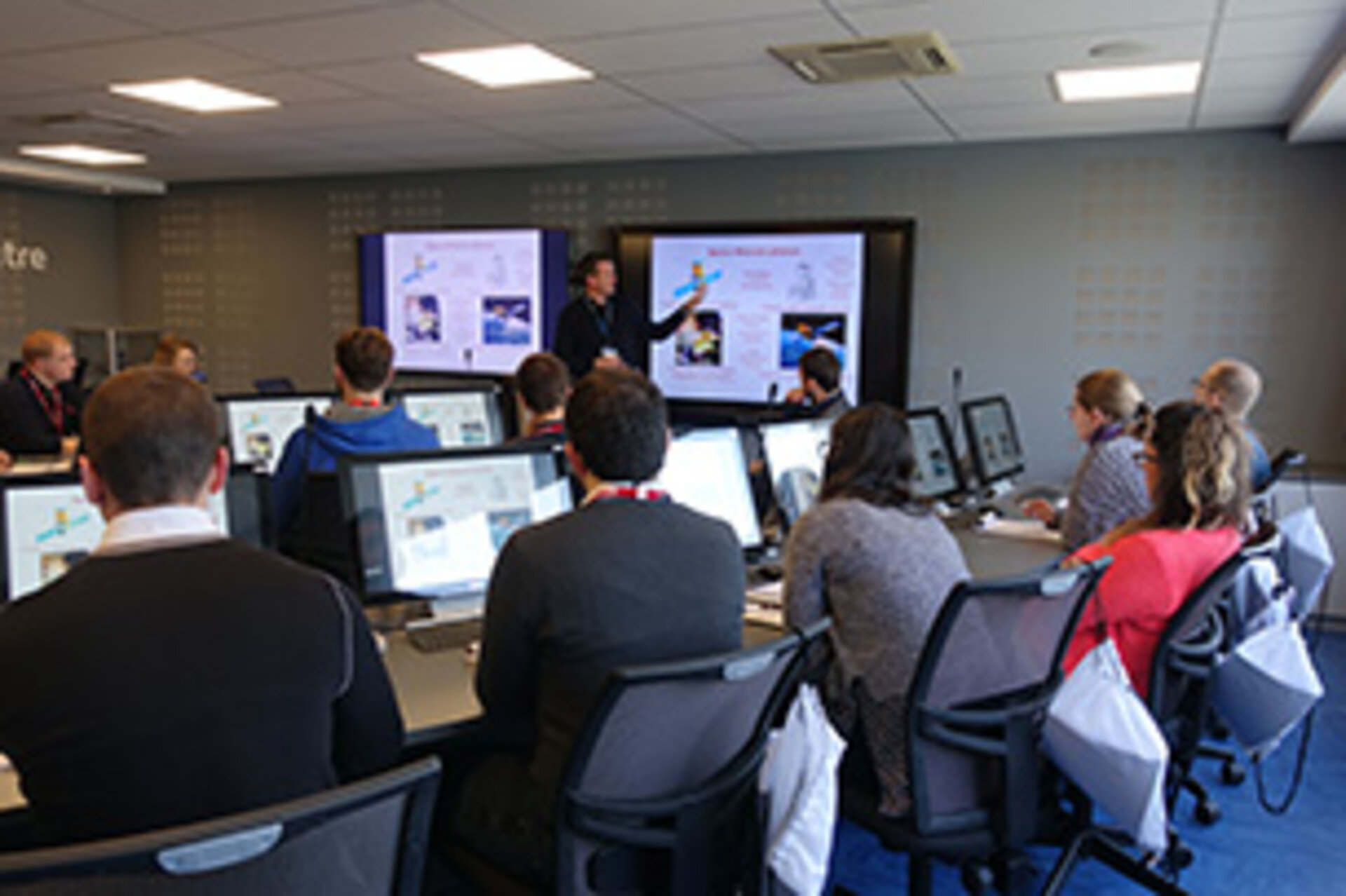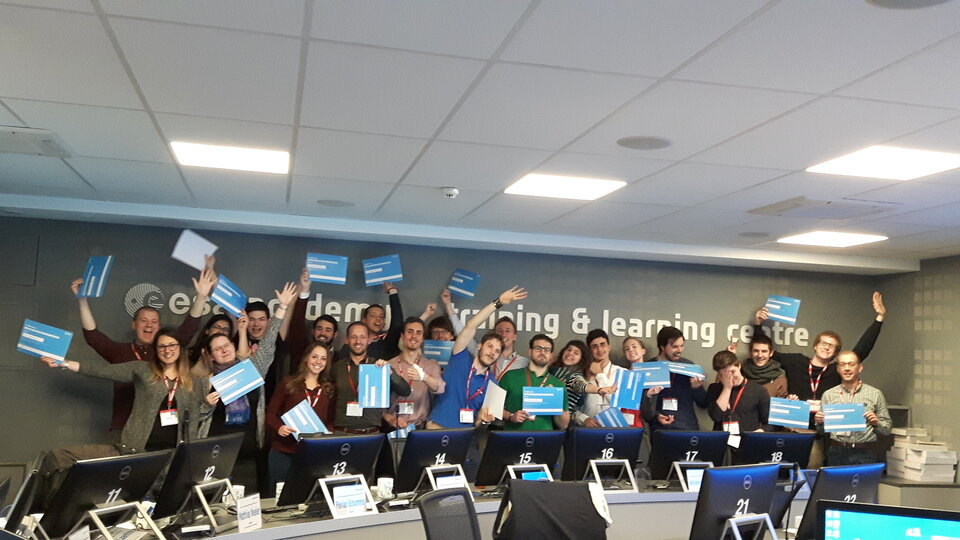Students successfully complete Concurrent Engineering Workshop
From 14 to 17 March 2017, 22 students from 11 different nationalities, including ESA Associate Member Canada, took part in a Concurrent Engineering Workshop.
Concurrent Engineering is a method of designing and developing products for the space sector. Contrary to traditional design methods, in Concurrent Engineering all subsystems are designed simultaneously.
Hosted at ESA Academy’s Training and Learning Centre, ESA Redu Centre, Belgium, students were trained by two System Engineers working at the Concurrent Design Facility (CDF) at the European Space Research and Technology Centre (ESTEC).
Students were assigned a specific mission: design a small single satellite that would rendezvous with Envisat, a large Earth observation satellite launched by ESA in 2002, but which stopped working in 2012. The main objective of the students’ small satellite – called e.Inspector – was to determine how Envisat is tumbling through space in order to collect data for a future mission to de-orbit it. Moreover, their satellite needed to accomplish this task without any risk of collision. Once the rotational rate was determined, it could spend the rest of its lifetime making observations of Earth, or performing other experiments.
The students were divided into teams, each covering a different subsystem:
- Configuration
- Structures
- Propulsion
- Mission Analysis
- Attitude and Orbit Control Subsystem (AOCS)
- Power
- Thermal
- Optics & Sensors
- Communication & Data Handling

The students began by creating a first iteration of the whole system. They then gradually and continually modified the subsystem designs, increasing the size of their satellite.
During the second and the third days they performed a second iteration and began to achieve very respectable results. They even calculated power and thermal budgets, and determined the dimensions and configuration of the mini-satellite.
The trainers were very impressed with the students’ work ethic. They were so motivated that they needed to be forced to take coffee breaks, and even then they kept on working!
On the last day the students froze the second iteration and presented their final subsystem designs. The experts then compared the results with the previous edition of this Concurrent Engineering Workshop where a different set of students had been given the same challenge.
Interestingly, the two groups started their study with similar assumption, but this time the students chose a different configuration for the satellite: instead of a CubeSat, as the earlier students had opted for, they chose a mini-satellite with a cubic shape, which led them to obtain different budgets. While the mini-satellite structure was larger, a simpler rendezvous approach was chosen that minimised cost.
The students were fascinated by comparing their work with that of their predecessors. They began a discussion on the advantages and disadvantages of the two different designs, and kept on debating throughout dinner!
The students finished the course having been inspired by the possibilities of Concurrent Engineering. Their designs may even have a lasting legacy: in May a Concurrent Engineering study of the e.Inspector satellite is expected to take place at ESTEC, and the results of the two educational Concurrent Engineering studies might be provided to the experts as starting points.

As a final farewell the students left glowing feedback of the course, a small selection of which feature below:
“The combination of different cultures, backgrounds and experiences between participants really makes this workshop a unique and enriching adventure to every kind of space-lover. In my opinion I learned equally as much speaking with other participants than during the training itself.”
Student from Belgium
“In the Concurrent Design Facility workshop I did a crash course in how a mission should be designed. I will definitely apply what I learned in the future. But the workshop is not only about concurrent engineering, is also about meeting motivated and interesting people from ESA and all its member states.”
Student from Portugal
“An amazing week in Redu! Working in the Concurrent Design Facility made me feel like a real spacecraft designer. Thanks to the guidance provided by highly qualified professionals we got fully involved with the mission proposed to us since the very first moment. Over the days, our subsystem designs started to get more and more concise and intertwined to each other, just like our friendship. Cause even better than working in space-related projects is doing it surrounded by a bunch of awesome European fellows.”
Student from Spain
- This was the 10th event organised in the ESA Academy Training and Learning Centre, and the 3rd event using the ESA Academy’s Educational Concurrent Design Facility (CDF).
- ESA Academy regularly run Courses, Workshops and Summer School similar to this Concurrent Engineering Workshop. To find out more, please visit the Current Opportunities webpage
- For more information about ESA Academy activities, please contact: esa.academy@esa.int



